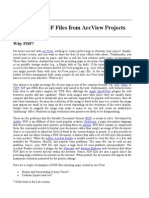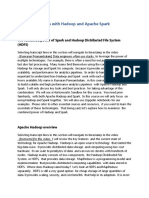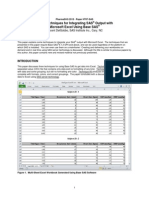Creating ZIP Files With ODS: Jack Hamilton, Division of Research, Kaiser Permanente, Oakland, California
Creating ZIP Files With ODS: Jack Hamilton, Division of Research, Kaiser Permanente, Oakland, California
Uploaded by
sasdoc2010Copyright:
Available Formats
Creating ZIP Files With ODS: Jack Hamilton, Division of Research, Kaiser Permanente, Oakland, California
Creating ZIP Files With ODS: Jack Hamilton, Division of Research, Kaiser Permanente, Oakland, California
Uploaded by
sasdoc2010Original Description:
Original Title
Copyright
Available Formats
Share this document
Did you find this document useful?
Is this content inappropriate?
Copyright:
Available Formats
Creating ZIP Files With ODS: Jack Hamilton, Division of Research, Kaiser Permanente, Oakland, California
Creating ZIP Files With ODS: Jack Hamilton, Division of Research, Kaiser Permanente, Oakland, California
Uploaded by
sasdoc2010Copyright:
Available Formats
SAS Global Forum 2013
Foundations and Fundamentals
Paper 131-2013
Creating ZIP Files with ODS
Jack Hamilton, Division of Research, Kaiser Permanente, Oakland, California ABSTRACT
ZIP files are a convenient way to bundle related files together, and can save storage space at the same time. The ZIP format is used internally by SAS for SAS Enterprise Guide projects, but until SAS 9.2 there was no native way to create a ZIP file with your own SAS program. Starting in SAS 9.2, you can create your own ZIP files using ODS PACKAGE statements. This presentation describes how to create simple ZIP archives, and discusses how to create an archive file with an internal directory structure.
INTRODUCTION
The ZIP file format was devised in the late 1980's by Phi Katz for his PKZIP utility. It has been updated over the years, and now incorporates several different compression algorithms. The ZIP algorithms are not always the most effective or efficient - there are several competitors that might work better in any given situation, that might compress better or faster or both - but it's a good overall performer. As a result, the ZIP format now used internally by many products (Java JAR files, SAS Enterprise Guide project files, etc.), in addition to being a standard format for distributing groups of files that a consumer might extract and use directly. Despite its wide use in the computer industry, reading and writing ZIP files has not historically been supported by SAS, even though DSD uses ZIP format files internally. Starting with SAS 9.2, it is possible to create ZIP files using SAS code. There is still no supported method for unzipping files (ask Mr. Google about "SAS saszipam " for an unsupported, undocumented method that often works). Rumor has it that an upcoming version of SAS will support reading and writing ZIP files through a new FILENAME engine.
ODS PACKAGES
Support for writing ZIP files in SAS 9.2comes as part of ODS, the source of so many great new features in SAS over the last few years. Its stated purpose is to create file packages as part of the SAS Publishing Framework, which is part of SAS's extensive product offerings for information distribution. But it's available in base SAS.
CREATING A PACKAGE AND ADDING FILES
To create a package, use the ODS PACKAGE statement with the OPEN option. Typically, you will give the package a name that indicates its purpose, as with any other name in SAS. Here's an example of creating a package named ProdOutput: ods package(ProdOutput) open nopf; The NOPF option tells SAS not to create an additional ZIP entry describing the contents of the ZIP file; you will not want that file, and in some versions of SAS omitting the NOPF option will cause an error if the Publishing Framework is not licensed. Next, you will add files to the package using the ADD FILE option: ods package(ProdOutput) add file='c:\temp\renal.xps'; You can specify either a complete file name and path, or a path relative to the current active directory. At this point, SAS is collecting information, but hasn't started to create the ZIP file yet. Finally, you tell SAS that it's time to write the ZIP file using the PUBLISH ARCHIVE option. The name of the ZIP file is also specified in this statement: ods package(ProdOutput) publish archive properties(archive_name='ProdOutput.zip' archive_path='c:\temp');
SAS Global Forum 2013
Foundations and Fundamentals
You will see a message in the log confirming that the ZIP file has been written: NOTE: Writing zip package c:\temp\ProdOutput.zip. Finally, tell SAS you're through adding files, using the CLOSE option: ods package(ProdOutput) close; If you look at the ZIP file (in this case, using the free utility 7-Zip), you can see the contents of the ZIP file (Figure 1):
Figure 1. Simple ZIP file shown in 7-Zip
CREATING AN INTERNAL DIRECTORY STRUCTURE
An additional option, PATH, in the ADD FILE allows you to specify an internal directory structure within your ZIP file: ods package(ProdOutput) add file='c:\temp\renal.xps' path='Diseases'; If you use this statement in place of the one above, the "renal.xps" file will be placed inside a directory in the ZIP file (Figure 2):
Figure 2. ZIP file with directories shown in 7-Zip.
SAS Global Forum 2013
Foundations and Fundamentals
AUTOMATING ZIPPING
The examples above assume that you know the names of all the files you will want to add to the ZIP file. If the file names vary, but you have the names in a SAS data set, you can write the ADD statements with CALL EXECUTE. filename dirlist pipe 'dir /b y:\wuss2012\*.sas'; data _null_; infile dirlist pad lrecl=80; input @1 filename $80.; call execute (catx (' ', 'ods package(vary)', 'add file=', quote('y:\wuss2012\' || trim(filename)), ';' ) ); run; You can create the data set containing file names while you are creating the files themselves, or in whatever other way you choose. For a platform-independent method of creating a list of files and directories in SAS, see http://www.sascommunity.org/wiki/Obtaining_A_List_of_Files_In_A_Directory_Using_SAS_Functions
CAUTIONS AND AMPLIFICATIONS
It does not seem to be possible to create an empty directory inside a ZIP file. It is not possible to encrypt a file while ZIPping it. You cannot use wild cards to specify files in an ADD statement. This might be a bug, or might be a feature, depending on how you look at it. You can't add files to an existing ZIP file. Using an existing ZIP file will delete it and create a new version without the previous entries. The files you want to add have to exist when the PUBLISH statement executes. You can use a fileref instead of a physical file name. There's no documented or supported way to read a ZIP file in SAS, even though the software obviously has the capability internally. The compression method SAS uses is compatible with every ZIP reader I have tried. It is not, however, always the most effective compression method.
FURTHER READING
A version of this paper is available online at http://www.sascommunity.org/wiki/Creating_a_ZIP_File_Using_Native_SAS_Features
REFERENCES
SAS Institute. Using ODS to Publish Packages. March 2013. Available at <http://support.sas.com/rnd/base/ods/odspackages/index.html>.
ACKNOWLEDGMENTS
I would like to thank Jamila Gul at the Kaiser Permanente Division of Research and Tom Billings at Union Bank for their help and encouragement.
SAS Global Forum 2013
Foundations and Fundamentals
CONTACT INFORMATION
Your comments and questions are encouraged. Contact the author at: Jack Hamilton jfh@acm.org
SAS and all other SAS Institute Inc. product or service names are registered trademarks or trademarks of SAS Institute Inc. in the USA and other countries. indicates USA registration. Other brand and product names are trademarks of their respective companies.
You might also like
- SAS Certified Professional Prep Guide: Advanced Programming Using SAS 9.4From EverandSAS Certified Professional Prep Guide: Advanced Programming Using SAS 9.4Rating: 1 out of 5 stars1/5 (2)
- Exercises and Projects for The Little SAS Book, Sixth EditionFrom EverandExercises and Projects for The Little SAS Book, Sixth EditionNo ratings yet
- C747 Transcripts Part1Document224 pagesC747 Transcripts Part1Jose0% (1)
- Detect It EasyDocument19 pagesDetect It EasyHazrat JuniorNo ratings yet
- Sap Open Text Imaging InstallationDocument8 pagesSap Open Text Imaging Installationkumudranjan100% (1)
- Five Features You Ought To Know About The Oracle SchedulerDocument37 pagesFive Features You Ought To Know About The Oracle SchedulerEddie AwadNo ratings yet
- A Hands-On Introduction To SAS Programming: Casey Cantrell, Clarion Consulting, Los Angeles, CADocument21 pagesA Hands-On Introduction To SAS Programming: Casey Cantrell, Clarion Consulting, Los Angeles, CAproudofskyNo ratings yet
- Mainframe SAS® For The 21 Century: Kryn Krautheim, National Center For Health Statistics, Research Triangle Park, NCDocument6 pagesMainframe SAS® For The 21 Century: Kryn Krautheim, National Center For Health Statistics, Research Triangle Park, NCsathya_145No ratings yet
- Smap CompDocument3 pagesSmap CompJumadil PutraNo ratings yet
- Programmer's Guide by Ron Cody: Example Code and Data For Learning SAS by Example: ADocument2 pagesProgrammer's Guide by Ron Cody: Example Code and Data For Learning SAS by Example: AmihirhotaNo ratings yet
- SAS0569-2017 Shared File Systems - Determining The Best Choice For Your SAS Foundation - Has Spectrum Scale ChapterDocument11 pagesSAS0569-2017 Shared File Systems - Determining The Best Choice For Your SAS Foundation - Has Spectrum Scale Chapterdaniel_vp21No ratings yet
- Solaris PackagingDocument21 pagesSolaris Packaginganil.kashyapNo ratings yet
- Example Code and Data For Learning SAS by ExampleDocument2 pagesExample Code and Data For Learning SAS by ExamplePuli SreenivasuluNo ratings yet
- How To Host A Cydia™ Repository: Step 1: Making A PackageDocument9 pagesHow To Host A Cydia™ Repository: Step 1: Making A PackageDavid BatesNo ratings yet
- Cloud PDFDocument47 pagesCloud PDFgladstondecruze.2k3No ratings yet
- Sas 9.4 Installation Tips - Updated August 2019Document4 pagesSas 9.4 Installation Tips - Updated August 2019Mvelako StoryNo ratings yet
- Creating PDF Files From Arcview ProjectsDocument5 pagesCreating PDF Files From Arcview ProjectsDaus AjaNo ratings yet
- PhreePlot (026 109)Document84 pagesPhreePlot (026 109)Jeison BlancoNo ratings yet
- b600 Use Permanent DataDocument7 pagesb600 Use Permanent DataAdriana PetreNo ratings yet
- Ansys TipsDocument5 pagesAnsys TipsdvarsastryNo ratings yet
- Issues DatastageDocument4 pagesIssues DatastagerkpoluNo ratings yet
- Kaldi For DummiesDocument13 pagesKaldi For DummiesSher Afghan MalikNo ratings yet
- McCarthy How To Configure Python and SASPyDocument7 pagesMcCarthy How To Configure Python and SASPyMikkel Boel SørensenNo ratings yet
- Kaldi For Dummies - FixedDocument11 pagesKaldi For Dummies - FixedAmna ZahidNo ratings yet
- Using Configuration Files in Data Stage Best PracticesDocument11 pagesUsing Configuration Files in Data Stage Best PracticesDileepkumar JangaNo ratings yet
- Castalia - InstallationDocument4 pagesCastalia - InstallationRim NegraNo ratings yet
- And Hadoop: Integration of Data and AnalyticsDocument7 pagesAnd Hadoop: Integration of Data and AnalyticsrsearchNo ratings yet
- SPSS Input-Output ModuleDocument140 pagesSPSS Input-Output Modulenofind31No ratings yet
- Overlays and Page Segments 2Document4 pagesOverlays and Page Segments 2vipin mudgalNo ratings yet
- Sun ZipDocument18 pagesSun ZipKunal BishtNo ratings yet
- Big Data Analytics With Hadoop and Apache SparkDocument17 pagesBig Data Analytics With Hadoop and Apache SparkFernando Andrés Hinojosa VillarrealNo ratings yet
- Everything Is Better With Friends PDFDocument20 pagesEverything Is Better With Friends PDFMikkel Boel SørensenNo ratings yet
- Hadoop Administration Interview Questions and Answers For 2022Document6 pagesHadoop Administration Interview Questions and Answers For 2022sahil naghateNo ratings yet
- OS1 - Project 2Document11 pagesOS1 - Project 2jackson678No ratings yet
- L Hadoop 1 PDFDocument12 pagesL Hadoop 1 PDFDao Van HangNo ratings yet
- Go Programming For Network Operations A Golang Network Automation HandbookDocument109 pagesGo Programming For Network Operations A Golang Network Automation HandbookKwaku AfframNo ratings yet
- Setting Up Your Postscript EnvironmentDocument4 pagesSetting Up Your Postscript EnvironmentlaoraculoNo ratings yet
- SQ L Server Final SoftDocument178 pagesSQ L Server Final SoftsvndkraoNo ratings yet
- How To Install SAS 9.3 For Windows: OIT Research Computing Support Customized by Dr. SchmidhammerDocument4 pagesHow To Install SAS 9.3 For Windows: OIT Research Computing Support Customized by Dr. SchmidhammernageshlksapNo ratings yet
- What Is .Pos FileDocument4 pagesWhat Is .Pos FilejackNo ratings yet
- Data Acquition and StorageDocument20 pagesData Acquition and Storagetejeswararao.addankiNo ratings yet
- 1) Discuss The Design of Hadoop Distributed File System (HDFS) and Concept in DetailDocument11 pages1) Discuss The Design of Hadoop Distributed File System (HDFS) and Concept in DetailMudit KumarNo ratings yet
- How To Publish A Package in RDocument14 pagesHow To Publish A Package in Rtoton1181No ratings yet
- A Hacker's Guide To SAS® Environment CustomizationDocument12 pagesA Hacker's Guide To SAS® Environment Customizationkmeena73No ratings yet
- I6comp ReadmeDocument3 pagesI6comp Readmejorgene0No ratings yet
- Python QB Solns (Mod 4)Document11 pagesPython QB Solns (Mod 4)adi28gowdaNo ratings yet
- Hadoop I/O: Jaeyong ChoiDocument36 pagesHadoop I/O: Jaeyong ChoiPrakash SharmaNo ratings yet
- Sender File Adapter Frequently Asked Questions - Process Integration - Community WikiDocument5 pagesSender File Adapter Frequently Asked Questions - Process Integration - Community WikifziwenNo ratings yet
- Hello !!: What Are Packages and Code ScriptsDocument16 pagesHello !!: What Are Packages and Code ScriptsYash ShirbhateNo ratings yet
- Routine To Fetch Current Day's Filename, Infopackage RoutineDocument12 pagesRoutine To Fetch Current Day's Filename, Infopackage RoutineSANJEEV SINGHNo ratings yet
- SQ L Server Final SoftDocument183 pagesSQ L Server Final SoftNaresh RamanadhamNo ratings yet
- Fstab DemystifiedDocument2 pagesFstab DemystifiedAmir AzizNo ratings yet
- Filesystem Spiffs  ESP8266 DocumentationDocument14 pagesFilesystem Spiffs  ESP8266 DocumentationLeandro NadalNo ratings yet
- Partitioned Data Set ExtendedDocument2 pagesPartitioned Data Set Extendedvenkata9927No ratings yet
- Batch File TipsDocument6 pagesBatch File TipsRashid AlsalamNo ratings yet
- 2019 Migration GuideDocument20 pages2019 Migration GuidesuprabhattNo ratings yet
- SAS For Windows Begining TutorialDocument206 pagesSAS For Windows Begining Tutorialiksingh05100% (3)
- Data Modeling and Database Design: Minder Chen, Ph.D. Mchen@gmu - EduDocument150 pagesData Modeling and Database Design: Minder Chen, Ph.D. Mchen@gmu - EduchandooklNo ratings yet
- Using 22 Easy Tricks With ODS To Generate Colorful Reports: Ben Cochran, The Bedford Group, Raleigh, NCDocument8 pagesUsing 22 Easy Tricks With ODS To Generate Colorful Reports: Ben Cochran, The Bedford Group, Raleigh, NCsasdoc2010No ratings yet
- Tranforming SAS Data SetsDocument41 pagesTranforming SAS Data Setssasdoc2010No ratings yet
- SAS Program Efficiency For BeginnersDocument10 pagesSAS Program Efficiency For Beginnerssasdoc2010No ratings yet
- STP Output To ExcelDocument19 pagesSTP Output To Excelsasdoc2010No ratings yet
- AIR2008 Fancy Departmental Excel ReportDocument38 pagesAIR2008 Fancy Departmental Excel Reportsasdoc2010No ratings yet
- SAS 9.3 Foundation Services: Administrator's GuideDocument62 pagesSAS 9.3 Foundation Services: Administrator's Guidesasdoc2010No ratings yet
- Advantages DSSSSSSDocument2 pagesAdvantages DSSSSSSPrecious Ndemwendemwene KapesiNo ratings yet
- Introduction To Network Security ThreatsDocument8 pagesIntroduction To Network Security Threatsiwc2008007100% (1)
- Whoops! There Was An Error PDFDocument1 pageWhoops! There Was An Error PDFJohnny Prendas GonzalezNo ratings yet
- PL/SQL Best Practices: InfosysDocument8 pagesPL/SQL Best Practices: InfosysshrinkedNo ratings yet
- Credit Management in S4 HanaDocument9 pagesCredit Management in S4 HanamukeshNo ratings yet
- Joshua Erdy Tan: Data Analyst/Professional TeacherDocument1 pageJoshua Erdy Tan: Data Analyst/Professional TeacherJoshua Erdy Alforja TanNo ratings yet
- Python Quant UqerDocument25 pagesPython Quant UqerSomphorn Z NambutNo ratings yet
- Advance Computer Programming: by Hasnat AliDocument48 pagesAdvance Computer Programming: by Hasnat Alidavid jhonNo ratings yet
- SQL Performance ExplainedDocument122 pagesSQL Performance Explainedi070174862No ratings yet
- Snort 3 GA On OracleLinux 8Document28 pagesSnort 3 GA On OracleLinux 8OlyteNo ratings yet
- MYSQL DDL COMMANDS v3 (Updated)Document20 pagesMYSQL DDL COMMANDS v3 (Updated)Sabbir HossainNo ratings yet
- Hameed Khan: Dallas/Fort Worth AreaDocument5 pagesHameed Khan: Dallas/Fort Worth Areaabid hamzaNo ratings yet
- An Efficient Technique For Detection and Prevention of SQL Injection Attack Using ASCII Based String MatchingDocument8 pagesAn Efficient Technique For Detection and Prevention of SQL Injection Attack Using ASCII Based String MatchingPramono PramonoNo ratings yet
- BasdatDocument3 pagesBasdatGanis Praban'sNo ratings yet
- CMD Commands 1Document3 pagesCMD Commands 1SiddheshNo ratings yet
- Microsoft SQL Server 2012 T-SQL FundamentlsDocument1 pageMicrosoft SQL Server 2012 T-SQL FundamentlsDreamtech PressNo ratings yet
- Spring Web MVC Cheat SheetDocument9 pagesSpring Web MVC Cheat Sheetdarwinvargas2011No ratings yet
- UntitledDocument13 pagesUntitledSMPIT Harum BrebesNo ratings yet
- SDS NewDocument14 pagesSDS NewPrashi JainNo ratings yet
- Sistem Informasi Manajemen Reservasi Kamar Hotel Berbasis Desktop Pada Hotel Lodaya BandungDocument34 pagesSistem Informasi Manajemen Reservasi Kamar Hotel Berbasis Desktop Pada Hotel Lodaya BandungbananaNo ratings yet
- Responsive Web Design With AngularJS Sample ChapterDocument34 pagesResponsive Web Design With AngularJS Sample ChapterPackt PublishingNo ratings yet
- Chapter 13: Programming Languages and Program DevelopmentDocument27 pagesChapter 13: Programming Languages and Program DevelopmentMuhammad Iqbal HanafriNo ratings yet
- Practical Exam: Aim: To Design A State Diagram For Online Shopping TheoryDocument4 pagesPractical Exam: Aim: To Design A State Diagram For Online Shopping Theoryanshul bharwdajNo ratings yet
- Aqa Gcse Computer Science Questions From NotesDocument4 pagesAqa Gcse Computer Science Questions From NotesDivaNo ratings yet
- Python Exception HandlingDocument20 pagesPython Exception HandlingEisen Ed BrionesNo ratings yet
- Flask DocsDocument273 pagesFlask DocsRamón Elías Cerrada MontoyaNo ratings yet
- Preparing The Environment For Oracle 19c RAC: Practice 19-ADocument24 pagesPreparing The Environment For Oracle 19c RAC: Practice 19-AAbderahman MohamedNo ratings yet
- Cypress IoDocument14 pagesCypress IoRock WatsonNo ratings yet
- Writing Secure Code: Target AudienceDocument2 pagesWriting Secure Code: Target AudiencefraNo ratings yet
































































































